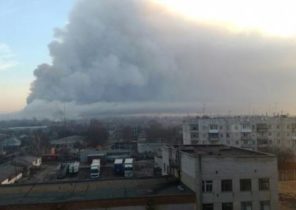Every summer, when the days are getting longer, Anastasia Makarieva leaves his laboratory in St. Petersburg and goes on vacation in the vast forests of the Russian North. Nuclear physicist splits the tent on the shore of the White sea, among the firs and pines, is floating on a canoe through the vast rivers of the region and making notes about the nature and the weather. “The forest is a big part of my personal life,” she says. For 25 years the annual pilgrimage to the North and they became an important part of her professional life.
For more than ten years Makarieva advocated the theory, which was developed together with Victor Gorshkov of his mentor and colleague from the St. Petersburg nuclear physics Institute (PNPI) — on how the boreal (taiga) forests of Russia, the largest forest of the Earth, regulate the climate of the Northern parts of Asia. This is a simple but far-reaching physical theory describes how trees exhaled water vapor creates winds — these winds cross the continent, bringing moist air from Europe across Siberia and on to Mongolia and China; these winds bring rains that feed the giant rivers of Eastern Siberia; the winds pour North China plain, the breadbasket of the most populous country on the planet.
With the ability to absorb carbon dioxide and exhale oxygen, the great forests are often called lungs of the planet. But Makarieva and Gorshkov (he died last year), we are convinced that they are still her heart. “The forest is a complex, self-sustaining rainwater system and the main factor of atmospheric circulation on Earth,” says Makarieva. They recycle a huge amount of moisture in the air and simultaneously create winds that pump the water around the world. The first part of this theory that forests make rain, consistent with the studies of other scientists about her increasingly reminded in water management against the backdrop of unrestrained deforestation. But the second part, the theory that calls Makarieva biotic pump, it is much more controversial.
Theoretical substantiation of the work was published — albeit in less prominent magazines and Makarieva supported a small group of colleagues. But the theory of the biotic pump of barrage of criticism, especially from developers of climate models. Some believe that the impact of the pump slightly, while others deny it altogether. The result Makarieva was in the role of the outsider: a theoretical physicist among modellers, Russian among Western scholars, and women in the areas where men call the shots.
However, if her theory is correct, it can explain why, despite the considerable remoteness from the oceans, in the interior of the wooded continents falls as much rain as on the coast, and why the inner areas of treeless continents, on the contrary, usually dry. Yet it follows from this that the forest — from the Russian taiga to the Amazon rainforest — not simply grow where the weather suits. They do. “From what I have read, I concluded that the biotic pump works,” says Douglas Shiel (Douglas Sheil), a forest ecologist from the Norwegian University of life Sciences. Because the fate of the world’s forests in question, he said: “Even if there is the slightest chance that this theory is correct, be sure to find out for sure”.
Many textbooks on meteorology still bring a diagram of the water cycle in nature, where the main cause of atmospheric moisture, which condenseries in the clouds and falls as rain is evaporation from the ocean. This scheme completely ignores the role of vegetation and especially trees, which work like giant fountains. Their roots draw from the soil the water for photosynthesis, and microscopic pores in the leaves evaporate any unused water in the air. This process is a kind of perspiration, but the trees — is called transpiration. Thus, one Mature tree releases hundreds of litres of water a day. Due to the extensive area of the forest foliage often emit in the air more moisture than a pond the same size.
Parade rain
So-called “flying rivers” — is the prevailing wind, which absorb the allocated forests water vapor and bring the rains in remote water basins. Controversial theory suggests that the winds themselves manage the forest.
According to the theory of the biotic pump, forests are not only rain but also wind. When water vapor above a coastal forest condenseries, the pressure of the air decreases and creates winds that suck moist ocean air. Cycles of transpiration and condensation creates the winds that bring the rains for thousands of kilometers inland.
So, about 80% of the precipitation in China comes from the West through the TRANS-Siberian flying the river. And flying of the Amazon river provides 70% of the precipitation in the South-Eastern part of South America.
The role of this secondary moisture in the nutritional education of the rains in fact were not taken into account until 1979, when the Brazilian meteorologist Eneas Salati (And Eneas) investigated the isotopic composition of rain water from the Amazon basin. It turned out that the water returned by transpiration, contains more molecules with the heavy isotope oxygen-18 than water is evaporated from the ocean. So Salati showed that half of the precipitation over the Amazon fell as a result of the evaporation of the forest.
Meteorologists tracked the atmospheric jet over the forest at an altitude of about 1.5 kilometers. These winds — collectively they are called the South American jet stream of lower layers, — blow from West to East across the Amazon with the speed of a racing bike, and then the Andes mountains entice them South. Salati and others have suggested that they are the main part of the emitted moisture, and dubbed them “flying river”. According to a climatologist from the National Institute for space research of Brazil antónio Nobre (Antonio Nobre), flying the river Amazon today carries as much water as earth’s giant river underneath.
For some time it was believed that the flying of the river are limited to a pool of Amazon. But in 1990-ies hydrologist from Deltsova technological University Hubert Savenije (Hubert Savenije) began to study the recycling of moisture in West Africa. Using hydrological models for weather data, he found that the farther inland from the coast, the higher the proportion of precipitation falling from scaffolding up to 90% in the interior. This discovery explains why the inner Sahel is becoming drier over the last century has vanished coastal forests.
One of the disciples of Savenye, Ruud van der ENT (Ruud van der Ent) developed his idea of creating a global model of the air stream of moisture. He brought together observations of rainfall, humidity, wind speed and temperature and the theoretical estimation of evaporation and transpiration, and created the first model of the transfer of moisture to the extent in excess of river basins.
In 2010, van der ENT and his colleagues published their conclusion: globally, 40% of all precipitation falls on the land, not the ocean. Often even more. Flying the Amazon river provides 70% of the precipitation in the basin of the river Rio de La Plata, which stretches through the southeastern part of South America. Van der ENT was somewhat surprised to find that China has 80% of its water gets from the West — mainly the Atlantic moisture, which process the taiga forests of Scandinavia and Russia. The journey has several stages — cycles of transpiration with associated rain — and it takes six months or more. “This contradicts the previous information that all the studying in high school, he says. — China is located near the ocean, the Pacific ocean, but most of its precipitation is moisture from the land far to the West.”
***
If Makarieva rights, forests provide not only moisture, but also create a wind that carries it.
Gorshkov, she worked for a quarter century. She started his apprentice at PNPI, is a division of the Kurchatov Institute is Russia’s largest Institute for nuclear research, both civilian and military. From the beginning they worked naosobitsu and studied ecology at the Institute, where physicists are studying the materials by using nuclear reactors and neutron beams. As theorists, she says, they had “an exceptional freedom of research and thought,” they were doing atmospheric physics, wherever she was. “Victor taught me: do not be afraid,” she says.
In 2007, they first outlined his theory of the biotic pump of the journal “Hydrology and Earth science”. It was considered provocative at the outset, because contrary to the longstanding principle of meteorology: the winds are due mainly to differential heating of the atmosphere. Rising warm air reduces the pressure located below the layers, essentially creating for themselves on the surface of the new space. In the summer, for example, the land surface heats up faster and draws moist breezes from the cooler ocean.
Makarieva and Gorshkov claim that is sometimes dominated by a different process. When water vapor from the forest condenseries in the cloud, the gas becomes liquid — and it takes up less volume. This reduces the air pressure and draws the air horizontally from areas with less condensate. In practice, this means that the condensation pump above the coastal forests, the sea breeze bringing moist air to the interior, where he eventually condenseries and falls as rain. If the forests extend further inland, the cycle continues, maintaining a moist wind for thousands of kilometers.
This theory turns the traditional view: it is not the atmospheric circulation controls the hydrological cycle, but on the contrary, the hydrological cycle regulates mass air circulation.
Sewed, and he became a supporter of the theory over ten years ago, considers it a development of the idea of the flying rivers. “They are not mutually exclusive, he says. Pump explains the power of rivers.” He believes that the biotic pump explains the “paradox cold Amazon”. From January to June, when the Amazon basin is colder than the ocean, strong winds blowing from the Atlantic into the Amazon — although the theory of differential heating would have to wait for the opposite. Nobre, another long-standing supporter, enthusiastically explains, “They are not from the data, and from fundamental principles”.
Even those who in theory is in doubt, agree that the loss of forests has far-reaching implications for climate. Many scientists argue that deforestation thousands of years ago led to the desertification of Australia lands and West Africa. There is a risk that deforestation lead to drought in other regions, for example, part of the Amazon rainforest will transform into Savannah. Agricultural areas of China, the African Sahel and the Argentine pampas is also in danger, says Patrick Keys (Patrick Keys), a chemist atmospheric from Colorado state University, Fort Collins.
In 2018, Keys and his colleagues used a model similar to the model of van der ENT, for tracing sources of precipitation for the 29 global cities. He found that a large part of the supply 19 of them dependent on distant forests, including Karachi (Pakistan), Wuhan and Shanghai (China), new Delhi and Calcutta (India). “Even small changes in precipitation caused by changes in land use on the leeward side, can have a big impact on the fragility of urban water supply,” he says.
Some models even suggest that deforestation, destroying the source of the moisture that threatens to change weather conditions far beyond the flying rivers. As you know, El Nino — the temperature variation of the wind and currents in the tropical Pacific ocean — indirectly affects the weather in remote locations. Similarly, the deforestation of the Amazon could reduce rainfall in the Midwest and snow in the Sierra Nevada, says the climatologist from the University of Miami Roni Avissar (Roni Avissar) that models these relationships. Far-fetched? “Not at all,’ he says. — We know that El niño is able to do, because, unlike deforestation, this phenomenon repeats itself, and we are seeing a pattern. Both are caused by small changes in temperature and moisture that is emitted into the atmosphere.”
Researcher, Stockholm University LAN Wang-Erlandsson (Lan Wang-Erlandsson), which examines the interaction of land, water and climate, said that it’s time to switch from the use of water and mineral resources within a particular river basin to changes in land use beyond. “We need a new international hydrological agreement to maintain forests in the areas of formation of air masses,” she says.
Two years ago at a meeting of the UN Forum on forests involving all governments, researcher land resources from the University of Bern David Ellison (David Ellison) presented a specific example. He demonstrated that up to 40% of the total amount of rainfall in the Ethiopian highlands, which are the main source of the Nile, is provided with moisture, which is returned from the forests of the Congo basin. Egypt, Sudan and Ethiopia are negotiating a long-overdue transaction under section Nile waters. But such an agreement will be meaningless, if deforestation in the Congo basin, away from the three countries will eliminate the source of moisture, suggested Allison. “The relationship between forests and water in managing the world’s freshwater supply is almost completely ignored”.
The biotic pump will raise rates even more, because it is assumed that the loss of forests will have an impact not only on moisture but also on the nature of the wind. Allison warns that the theory, if it is confirmed, will have “crucial to circulation models of planetary air” — especially for those that carry moist air inland.
***
But while the supporters of the theory are in the minority. In 2010, Makarieva, Gorshkov, Sewed, Nobre and Bai-Liang Lee, an ecologist from the University of California at riverside, presented his historical description of the biotic pump, “Atmospheric chemistry and physics”, a major thematic journal with open peer review expert. But the article “Where are the winds?” on the Internet criticized, and the magazine took a lot of months to find only two scientists to review. Meteorological lab geophysical fluid dynamics Princeton University Isaac held (Isaac Held) volunteered and encouraged the publication of refuse. “No it’s not a mysterious effect, he says. — It is generally minor and also already taken into account in a number of atmospheric models”. Critics say that the expansion of air by heat, which is released when condensing water vapor counteracts the effect of the spatial condensation. But Makarieva says that these two effects are separated spatially: the warming occurs at altitude, and pressure drop condensation occurs closer to the surface, where the biotic wind.
Another reviewer was Judith Curry (Judith Curry), physicist atmospheric from Georgia Institute of Technology. She had long worried about the state of the atmosphere and considered that the article should be published because “the opposition bad effect on climate, and she needed blood from his nose physics.” After three years of debate, the editor of the recommendation held rejected and the article was published. She said that publication cannot be considered an endorsement, but it will provide a scientific dialogue on the controversial theory to confirm or refute.
Since neither confirmation nor refutation did not work — the confrontation continued. Specialist in climate modelling from Columbia University Gavin Schmidt (Gavin Schmidt) said: “It’s just nonsense.” The authors respond to criticism this way: “In fact, they’re out of mathematics are not sure whether to continue the dialogue.” Brazilian meteorologist and head of the National centre for monitoring and warnings of natural disasters Jos Marengo (Jose Marengo) says “I think that pump exists, but now it’s all on the level of theory. Specialists in climate models didn’t take it, but Russian is the best theorists in the world, so it is necessary to conduct relevant field experiments to test”. But so far no one, not even herself Makarieva, such experiments are not offered.
For its part, relies on Makarieva’s theory, arguing in a series of recent works that the same mechanism may affect tropical cyclones, their results in the action of the heat produced during condensation of moisture over the ocean. In the paper “Atmospheric research” in 2017, she and her colleagues have suggested that biotic pumps in rich forests attract moist air from the birthplace of cyclones. This, according to her, explains why cyclones rarely form in the South Atlantic ocean: tropical forests of the Amazon and the Congo have withdrawn so much moisture that it is too little and hurricanes is not enough.
Lead researcher hurricanes mit’s Kerry Emanuel (Kerry Emanuel) said that the proposed effects “although significant, but insignificant.” The lack of hurricanes in the South Atlantic he prefers other explanations, for example, cool water of the region are in the air, less moisture, and strong winds prevent the formation of cyclones. Makarieva, for its part, equally neglects the traditionalists, believing that some of the existing theories about the intensity of hurricanes “are contrary to the laws of thermodynamics”. She has another article in the “Journal of the atmospheric Sciences” — under review. “We worry that, despite the support of the editor, our work will again be rejected,” she says.
Let the West ideas Makariou considered marginal, in Russia, they are gradually taking root. Last year the government started a public dialogue on the revision of the laws on forestry. With the exception of the old protected areas of the Russian forests open to commercial exploitation, but the government and the Federal forestry Agency is considering a new category of forests for climate protection. “Some of our representatives of the forest Department were impressed by the idea of the biotic pump and want to enter a new category,” she says. The idea was supported by the Russian Academy of Sciences. Makarieva says that to be part of the consensus, not the eternal outsider, new and unusual.
This summer, her trip to the North woods tore the epidemic is coronavirus and quarantine. At home in St. Petersburg, she lingers for another round of objections from the anonymous reviewers. She is convinced that the theory of the pump will win sooner or later. “In science there is a natural inertia,” she says. With a grim Russian sense of humor, it recalls the words of the legendary German physicist max Planck (Max Planck), who gave the famous description of the progress of science: “a succession of funerals”.






